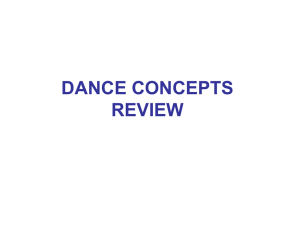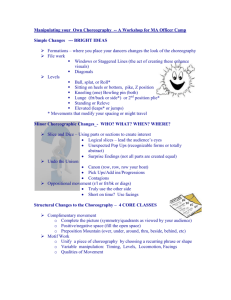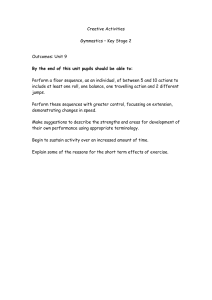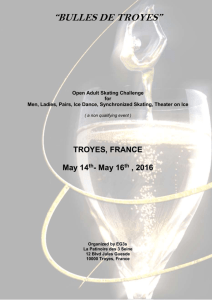Choreography Vocabulary List 2
advertisement
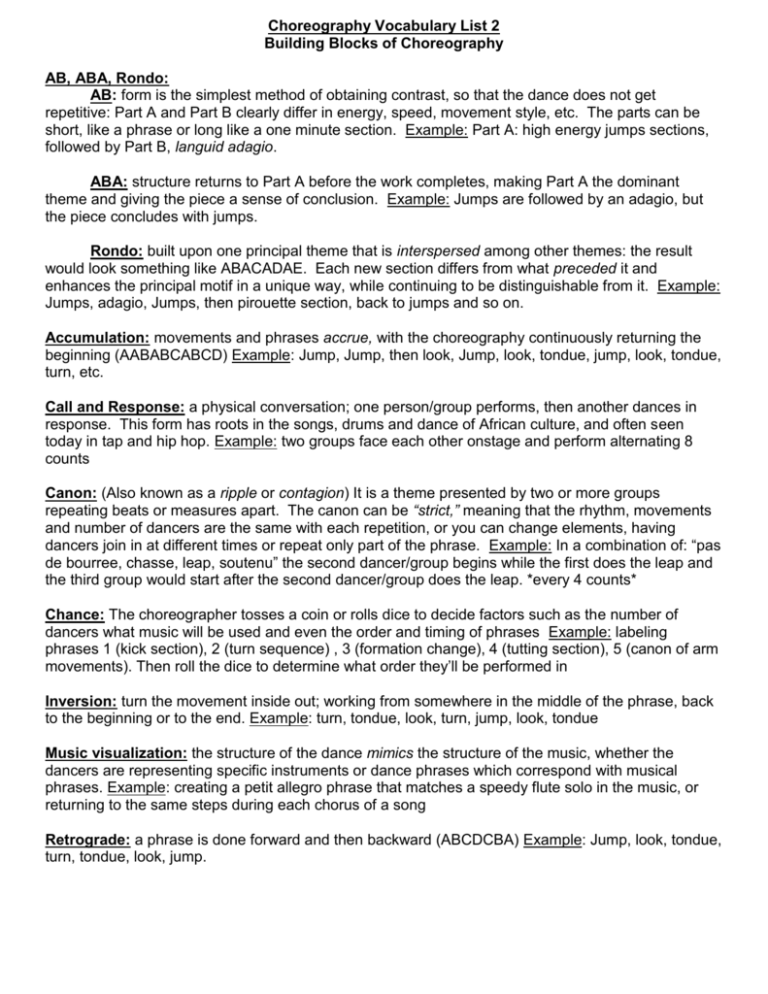
Choreography Vocabulary List 2 Building Blocks of Choreography AB, ABA, Rondo: AB: form is the simplest method of obtaining contrast, so that the dance does not get repetitive: Part A and Part B clearly differ in energy, speed, movement style, etc. The parts can be short, like a phrase or long like a one minute section. Example: Part A: high energy jumps sections, followed by Part B, languid adagio. ABA: structure returns to Part A before the work completes, making Part A the dominant theme and giving the piece a sense of conclusion. Example: Jumps are followed by an adagio, but the piece concludes with jumps. Rondo: built upon one principal theme that is interspersed among other themes: the result would look something like ABACADAE. Each new section differs from what preceded it and enhances the principal motif in a unique way, while continuing to be distinguishable from it. Example: Jumps, adagio, Jumps, then pirouette section, back to jumps and so on. Accumulation: movements and phrases accrue, with the choreography continuously returning the beginning (AABABCABCD) Example: Jump, Jump, then look, Jump, look, tondue, jump, look, tondue, turn, etc. Call and Response: a physical conversation; one person/group performs, then another dances in response. This form has roots in the songs, drums and dance of African culture, and often seen today in tap and hip hop. Example: two groups face each other onstage and perform alternating 8 counts Canon: (Also known as a ripple or contagion) It is a theme presented by two or more groups repeating beats or measures apart. The canon can be “strict,” meaning that the rhythm, movements and number of dancers are the same with each repetition, or you can change elements, having dancers join in at different times or repeat only part of the phrase. Example: In a combination of: “pas de bourree, chasse, leap, soutenu” the second dancer/group begins while the first does the leap and the third group would start after the second dancer/group does the leap. *every 4 counts* Chance: The choreographer tosses a coin or rolls dice to decide factors such as the number of dancers what music will be used and even the order and timing of phrases Example: labeling phrases 1 (kick section), 2 (turn sequence) , 3 (formation change), 4 (tutting section), 5 (canon of arm movements). Then roll the dice to determine what order they’ll be performed in Inversion: turn the movement inside out; working from somewhere in the middle of the phrase, back to the beginning or to the end. Example: turn, tondue, look, turn, jump, look, tondue Music visualization: the structure of the dance mimics the structure of the music, whether the dancers are representing specific instruments or dance phrases which correspond with musical phrases. Example: creating a petit allegro phrase that matches a speedy flute solo in the music, or returning to the same steps during each chorus of a song Retrograde: a phrase is done forward and then backward (ABCDCBA) Example: Jump, look, tondue, turn, tondue, look, jump. Rhapsodic and Narrative: dance that express pure feeling “rhapsodies”- emotion is the tie that holds the composition together. Example: conveying a sense of sadness or loss through movement. Narratives follow a storyline, and may convey specific meaning or concepts through that story. Example: retelling a fairytale or following a story from your life. Theme and Variation: Choreography that is presented and then repeated with changes, while still retaining enough of the theme that the original movement is recognizable. The significance of the original theme increases as it’s examined in its variations. Any number of tactics may be applied to the main phrase to create a variation, including: altering the tempo, rhythm or direction in which the pattern is performed applying another structural tactic to the movement such as inversion changing the style or mood (from contemporary to hip hop, from sad to happy) repeating or lengthening portions of the theme, while omitting others Example: Taking a phrase composed of developpes and port de bras, then trying it at twice the speed, or with only arms, or completely in reverse. With any theme, begin with simple steps, so there are plenty of variation options.






